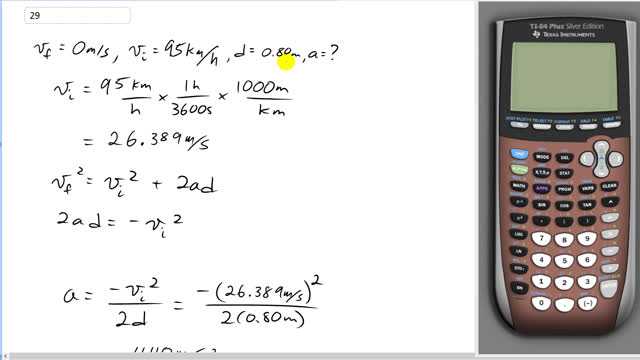
A car traveling at 95 km/h strikes a tree. The front end of the car compresses and the driver comes to rest after traveling 0.80 m. What was the magnitude of the average acceleration of the driver during the collision? Express the answer in terms of "g's", where .

In order to watch this solution you need to have a subscription.
This is Giancoli Answers with Mr. Dychko. When the driver hits the tree, their final velocity will be 0 meters per second; they start with a velocity of 95 kilometers an hour and the car gets squished over a distance of 80 centimeters or 0.8 meters and the question is what's the driver's acceleration? So first we'll convert the initial velocity into meters per second multiplying 95 kilometers an hour by 1 hour for every 3600 seconds so the hours cancel leaving us with seconds on the bottom and then times by a 1000 meters per kilometer and kilometers cancel, leaving us with meters on the top and multiplying by a 1000 and dividing by 3600 is the same as dividing by 3.6 so that's what I just did here and we have this for the initial velocity and this is the formula that contains all these letters, all these variables most of which we know and only one which we don't so that's why it's the ticket because it only has one unknown in it and this is zero—final velocity— and we'll subtract v i squared from both sides is, I guess, the way you can look at it and then switch the sides around so that you have 2ad equals negative initial velocity squared then divide both sides by 2d and you get acceleration is negative of the initial velocity— 26.389 meters per second and square that divide by 2 times the displacement— 0.8 meters— and you get negative 440 meters per second squared with two significant figures. And then the number of g's experienced put this into context compared to what it feels like to experience gravity we have this we take the unrounded answer, 435.23, keep at least two significant figures beyond what you are supposed to keep in the final answer so we are gonna have two significant figures in the answer and so we have five in this number here times by 1 g for every 9.8 meters per second squared the meters per second squared's cancel leaving us with negative 44 g's which is definitely gonna cause some injury and there's this guy—if you look on Wikipedia— who holds the record for experiencing g's and on a rocket sled, 46.2 g's but he didn't always do so well this is the picture of him quite a courageous guy I guess but he was experimenting on what kind of g's people could tolerate and using the army or air force I guess and after he would finish his experiments, he would be blind for short periods of time and so on but you can find out more about him if you google the internet John Stapp is his name.
Quick question: in the solutions manual it says that the final answer is the absolute value of acceleration, so 440m/s^2 and 44g's respectively. I was under the impression that whenever an object is slowing down (in the positive direction) it should have a negative acceleration. so i was just curious why one would use the absolute value in this case? my only guess is that it has something to do with how the question is worded.
Thanks!
Hi jacobproano-1, thanks a lot for the question. Yes, the issue here is in the wording. The problem asks for the magnitude of the acceleration. This means just give the number without any negative sign. It's meant to be a slightly easier question since now there's no need to be concerned about whether the answer is negative or not.
Your comment is correct about the sign. The way I would put it is that when an object is slowing down, the acceleration has the opposite sign to the velocity. Putting it that way means the acceleration can be one of two possibilities. Either it can be as you described above, or the acceleration could be in the positive direction given that the object is travelling in the negative direction.
Best wishes with your studies,
Mr. Dychko
Oh, and as a result of your good comment, I put the note "while the video correctly mentions that the acceleration is negative, the final answer should technically be positive, as written above, since the question asks for the magnitude of the acceleration." and updated the quick answer to be positive.
Thanks very much,
Mr. Dychko